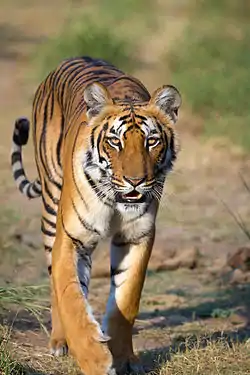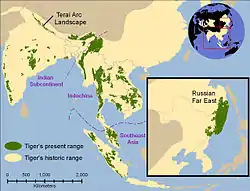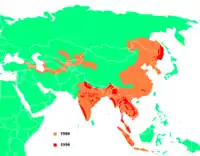ကျား
ကျားများသည် ယေဘုယျအားဖြင့် ၁၁ ပေခန့် ရှည်လျား၍ အလေးချိန်အားဖြင့် ၃၃၀ ကီလိုဂရမ် (၆၆၀ ပေါင်) ခန့်ရှိကြသည်။ ကျားတစ်ကောင်၏ အစွယ်သည် ယေဘုယျအားဖြင့် ၄ လက်မခန့် ရှည်သည်။ အချို့ကျားများသည် ၎င်းထက်ပင် ပို၍ ရှည်လျားကြသည်။ တောတွင်း သဘာဝပတ်ဝန်းကျင်တွင် အသက်အားဖြင့် ၁၀ နှစ်မှ ၁၅ နှစ်ခန့်ထိ နေထိုင်နိုင်ကြသည်။ ၎င်းကို ချုပ်လှောင်မွေးမြူထားပါက အသက် ၂၀ ထိ ရှည်နိုင်ကြသည်ကိုတွေ့ရသည်။ ခြင်္သေ့သည် အာဖရိကတိုက်များတွင် စိုးမိုးနေသည်ကို တွေ့ရသကဲ့သို့ ကျားသည်လည်း အာရှတိုက်တစ်ခွင်တွင် သားကောင်များပေါ်၌ မင်းမူလျက်ရှိသည်ကို တွေ့ရသည်။ အကယ်စင်စစ်ကျားမှာ ကျားဆရာကြောင်ဟုသော ဆိုရိုးစကားအတိုင်း ကြောင်မျိုးရင်း တွင်ပါဝင်သည်။ အိမ်တွင်လက်သတ်မွေးထားသော ကြောင်နှင့်နိုင်းစာကြည့်ပါက အရွယ်အစားကြီးမားခြင်းမှလွဲ၍ ခြားနားမှုများစွာ မရှိလှသည်ကို တွေ့ရသည်။
| ကျား | |
 | |
| ဘင်္ဂလားကျား တစ်ကောင် (P. tigris tigris) | |
| သဘာဝထိန်းသိမ်းခြင်းအခြေအနေ | |
 | |
| သိပ္ပံနည်းကျမျိုးခွဲခြင်း | |
| လောက | တိရစ္ဆာန် |
| မျိုးပေါင်းစု | Chordata |
| မျိုးပေါင်း | နို့တိုက်သတ္တဝါ |
| မျိုးစဉ် | အသားစားသတ္တဝါ |
| မျိုးရင်း | ကြောင်မျိုးရင်း |
| မျိုးစု | Panthera |
| မျိုးစိတ် | P. tigris |
| ဒွိနာမ | |
| Panthera tigris၊ Linnaeus, 1758 | |
| အမည်ကွဲ | |
| Felis tigris Linnaeus, 1758 Tigris striatus Severtzov, 1858 Tigris regalis Gray, 1867 | |
 | |
| ကျား တွေ့ရှိရာဒေသ | |

ကျားသည် တောက်ပြောင်လှပသော အသွေးအမွေး၊ အချိုးအစားကျနပြေပြစ်သော ကိုယ်လုံးကိုယ်ထည်၊ ဖျတ်လတ်ပေါ့ပါးသော ကိုယ်ဟန်တို့ကြောင့်၊ ကြောင်မျိုးဝင် တိရိစ္ဆာန်အပေါင်းတို့တွင် အလှပဆုံးနှင့် အချိုးအကျဆုံးဖြစ်သည်။ အာရှတိုက်တစ်ခွင်လုံးတွင် ကျားအမျိုးမျိုး ရှိသည့်အနက် ဘင်္ဂလားကျားမျိုးမှာ လူသိအများဆုံးဖြစ်သည်။ အခြားအတော်အသင့် လူသိများသော ကျားမျိုးတို့မှာ မန်ချူးရီးယားကျား၊ ကော်ကေးရှားကျားနှင့် ပသျှူးကျားမျိုးတို့ ဖြစ်သည်။ လူသိအများဆုံး ဘင်္ဂလားကျား၏အသွေးအမွေးမှာ အခြားကျားများနှင့် မတူ၊ နီဝါဝါအရောင် ရှိပြီးလျှင် တစ်ကိုယ်လုံးတွင် အနက်ရောင် အစင်းကြီးများဖြင့် လှပစွာရှိသည်။ ကျားကို သဘာဝက ဤကဲ့သို့ မြေကြီးနှင့် ခွဲမရအောင် ရောင်စုံခြယ်၍ ပေးထားသောကြောင့် တောချုံ ပိတ်ပေါင်းများအကြား သို့မဟုတ် မြက်ရှည်တောကြီးများ၏ အလယ်တွင် ရှိနေလျှင်၊ ကျားမှန်း ရုတ်တရက် ခွဲခြားသိရှိနိုင်ရန် ခဲယဉ်းသည်။

ကြောင်မျိုးတွင် ပါဝင်သော တိရစ္ဆာန်များမှာရေနှင့် များစွာမနီးစပ်ကြချေ။ သို့သော် ကျားမှာ ဤသို့မဟုတ်ဘဲ တစ်မျိုးတစ်ဖုံ ထူး နေသည်ကို တွေ့ရသည်။ ကျားသည် ရေကူး ကျင်လည်၏။ ထိုမျှသာမက အလွန့်အလွန်အခက်အခဲ အကျဉ်းအကျပ်နှင့်တွေ့သည့်အခါများတွင် သစ်ပင်ကိုပင် တက်နိုင်သေးသည်။ ကြောင်ကဲ့သို့ ညည့်အချိန်တွင် ပို၍ မျက်စိစူးသဖြင့် နေ့အချိန်တွင် သားကောင်လိုက်လေ့ မရှိဘဲ ညအခါမှသာ လှည့်လည်ကျက်စားလေ့ရှိသည်။ အစာရှာထွက်သည့်အခါတွင် အမဲကောင်ကို မှောင်ခိုပုန်းလျိုး၍ အုပ်ဖမ်းသတ်ဖြတ်စားသောက်တတ်သည်။ သားကောင်လိုက်ရာတွင် အလွန်ပင် ရဲစွမ်းသတ္တိရှိ၍ မည်သည့် သတ္တဝါမျိုးကိုမဆို အယဉ် အရိုင်းမရွေး တွေ့မရှောင် ကိုက်သတ်လေ့ရှိသည်။

ကျားသည် လူကို အလိုအလျောက် ရန်ပြုခဲသည်။ လူကို သတ်ဖြတ်စားသောက်ရန် အပတ်တကုတ် ကြိုးပမ်းအားထုတ်လေ့မရှိပေ။ သို့ရာတွင် လူ၏အသားကို တစ်ကြိမ်တစ်ခါမျှ မြိုးမြိုးမြက်မြက် စားလိုက်ရဖူးသော ကျားသည် လူကိုပင်လိုက်လံ သတ်ဖြတ်စားသောက်တတ်သည်။ ယခင်က စားခဲ့ဖူးသော အခြားအသားအားလုံးကို ပစ်ပယ်၍၊ လူ၏ အသားကိုသာ တန်းတန်းစွဲ တပ်မက်၍ နေသော ကျားမှာ အမှန်ပင် ကြောက်စရာကောင်းပေသည်။ အိန္ဒိယနှင့် မြန်မာနိုင်ငံတို့ရှိ တောထူထပ်သောနေရာများတွင် ကျားကို အလွန်တရာကြောက်ရွံ့ကြသည်။ အထူးသဖြင့် အိန္ဒိယတိုင်းရင်းသားများသည် ကျားကို လွန်စွာကြောက်ရွံ့ကြသည်။ အဘယ်ကြောင့်ဆိုသော် ထိုအရပ်ဒေသများတွင် တစ်နှစ်တစ်နှစ်လျှင် ကျားကြောင့် လူတစ်ထောင်မျှ သေဆုံးကြရသောကြောင့်ဖြစ်သည်။ အသက်အရွယ်ငယ်သေးသော ကျားပျိုများသည် သန်စွမ်းရဲရင့်ကြသဖြင့် ကျားအိုများထက် ပို၍ကြောက်စရာကောင်းသည်။
အမဲလိုက်သမားများသည် ကျားပစ်ထွက်ရာ၌ အသက်ဆံဖျား စွန့်စားရသည်။ အချို့ကျားပစ်သမားများသည် ကျားကို ဆင်ပေါ်မှ အကာအကွယ်ယူ၍ ပစ်လေ့ရှိကြ၏။ အချို့မှာလည်း ကျွန်ုပ်တို့ မြန်မာနိုင်ငံ၌ မကြခဏတွေ့ရသည့်အတိုင်းပင် လင့်စင်ထိုးကာ ပစ်လေ့ရှိသည်။ ထိုသို့ပစ်သည့်အခါတွင် မိမိတို့အလိုရှိသည့် နေရာသို့ ကျားရောက်လာစေရန် ပစ်ကွင်းတွင် အမဲသေတစ်ကောင်ဖြင့် မျှားခေါ်ရသည်။

သို့သော် ကျားကို ပစ်ခတ်ဖမ်းယူရန်မှာ ထင်သလောက်မလွယ်ကူချေ။ အဘယ့်ကြောင့်ဆိုသော် ကျားသည် အကောင်ပင်ကြီးသော်ငြားလည်း အလွန်ပေါ့ပါးဖျတ်လတ်သောကြောင့် ဖြစ်သည်။ ကျားမှာ အစာကို ရှာဖွေရာ၌သော် လည်းကောင်း၊ အစာရှာဖွေရာတွင် တွေ့ရသော အန္တရာယ်များကို ရှောင်ကွင်းရာ၌သော်လည်းကောင်း၊ အံ့ဩဖွယ်ကောင်းလောက်အောင် ပါးနပ်လျင်မြန်ရုံသာမက၊ ရဲလည်း ရဲရင့်ပေသည်။ ကျားမှာ သူဇာတိတောရိုင်းဒေသနယ်တွင်ဖြစ်မူ အသွေးအသားကို လိုချင်မက်မောသော သတ္တဝါဖြစ်သည်။ လွတ်လွတ်လပ်လပ် မနေရဘဲ ချုပ်နှောင်ခံနေရသောအခါ ကျားသည် မည်သူ့ကိုမဆို သစ္စာဖောက်ဖျက်လျက် အသက်ကို ရန်မူရန် အခွင့်အရေးကို အမြဲတမ်း ရှာဖွေနေတတ်သည်။ ထို့ကြောင့် တိရစ္ဆာန်ရုံများသို့ အလည်အပတ်သွားသည့်အခါတွင် ကျားကို သွားမစဘဲ စည်းကမ်းသေဝပ်စွာ ကြည့်ရှုရန် သတိပြုရမည်။
အမဲလိုက်ခြင်း
များသောအားဖြင့် ကျားများသည် တောတွင်းတွင် အကြီးစားသတ္တဝါများနှင့် အလတ်စားသတ္တဝါများ (ပေါင် ၂၀၀ ဝန်းကျင်ခန့်ရှိသော) ကို အမဲလိုက်စားသောက်လေ့ ရှိသည်။ ယေဘုယျအားဖြင့် ကျားများသည် အလွန်ကြီးမားသော အရွယ်ရောက်ပြီး အာရှဆင်များနှင့် အိန္ဒိယကြံများကို အမဲလိုက်လေ့ မရှိပေ။
မျိုးပွားခြင်း နှင့် မျိုးစပ်ခြင်း
ကျားအမသည် တစ်ကြိမ်လျှင် ၂ ကောင်မှ ၅ ကောင်အထိ သားပေါက်တတ်၏။ မွေးဖွားပြီးစတွင် ကျားကလေးသည် မိခင်ကျားမကြီးနှင့် အချိန်အတန် ကြာသည့်တိုင်အောင် အတူတကွ နေထိုင်လေ့ရှိ၏။ အသက်သုံးနှစ်အရွယ်ခန့်တွင် သားကောင်လိုက်ပုံလိုက်နည်းကို မိခင်ကျားမကြီးက သေချာစွာ သင်ကြားပြသပေးသည်။ ထို့နောက်မှ မိမိဘာသာအလျောက် တစ်သီးတစ်ခြားသားကောင် လိုက်ထွက်နိုင်သည်။ တိရစ္ဆာန်ရုံများတွင် ယခုအခါ [[ခြင်္သေ့နှင့် ကျားကို အတူတကွ မျိုးစပ်ပေါက်ဖွားစေနိုင်သည်ကို တွေ့ရ၏။ဖခင်က ကျား၊ မိခင်ကခြင်္သေ့မဖြစ်လျှင် ကျားခြင်္သေ့ဟု ခေါ်၍ မိခင်ကကျားမ၊ ဖခင်က ခြင်္သေ့ဖြစ်လျှင် ခြင်္သေ့ကျားဟုခေါ်ကြလေသည်။

ကျားမျိုးသုဉ်းပျောက်ကွယ်မှုအန္တရာယ်
၂၀၁၀ခုနှစ်သည် တရုတ်ရိုးရာပြက္ခဒိန်အရ ကျားနှစ်ဖြစ်ပြီး သဘာဝပတ်ဝန်းကျင်နှင့် တောရိုင်းတိရစ္ဆာန် ထိန်းသိမ်းစောင့်ရှောက်ရေး ပညာရှင်များ၏ ကွင်းဆင်းလေ့လာထားသော စစ်တမ်းများအရ ကမ္ဘာတစ်ဝန်းလုံးတွင် ကျားမျိုးကောင်ရေ (၃၆၀၀)ခန့်သာကျန်ရှိတော့သဖြင့် မျိုးသုဉ်းပျောက်ကွယ်နိုင်သည့်အန္တရာယ်နှင့် ရင်ဆိုင်နေရသည်။ ပညာရှင်တို့၏ မှတ်တမ်းများအရ လွန်ခဲ့သော နှစ်(၁၀၀)ခန့်က ကမ္ဘာပေါ်တွင် ကျားကောင်ရေစုစုပေါင်း တစ်သိန်းခန့်ရှိခဲ့ပြီး နှစ်တစ်ရာကာလအတွင်း ဤမျှအထိလျော့ကျသွားခြင်းဖြစ်သည်။ ရုရှား ဝန်ကြီးချုပ် ဗလာဒီမီယာပူတင်နှင့် ကမ္ဘာ့ဘဏ်ဥက္ကဋ္ဌ မစ္စတာ ရောဘတ်ဇိုးလစ် (Robert Zoellick) တို့၏ ဦးဆောင်စီစဉ်မှုဖြင့် အပြည်ပြည်ဆိုင်ရာ ကျားမျိုးထိန်းသိမ်းစောင့်ရှောက်ရေး ဖိုရမ်ကို ၂၀၁၀ခုနှစ် နိုဝင်ဘာလ (၂၁)ရက်နေ့တွင် ရုရှားနိုင်ငံ၊ စိန့်ပီတာစဘာ့တ်မြို့တွင် ကျင်းပရန်ရှိသည်။ ကျားကောင်ရေလက်ကျန်ရှိနေသေးသော နိုင်ငံများဖြစ်ကြသည့် ဘင်္ဂလားဒေ့ရှ်၊ ဘူတန်၊ တရုတ်၊ အိန္ဒိယ၊ အင်ဒိုနီးရှား၊ ကမ္ဘောဒီးယား၊ လာအို၊ မြန်မာ၊ မလေးရှား၊ နီပေါ၊ ထိုင်း၊ ဗီယက်နမ် စုစုပေါင်း (၁၃)နိုင်ငံမှ ခေါင်းဆောင်များ တက်ရောက်ဆွေးနွေးကြမည်ဖြစ်သည်။ ပညာရှင်များ၏ ခန့်မှန်းချက်အရ ထိန်းသိမ်းစောင့်ရှောက်ခြင်းမပြုပဲ ယခုအတိုင်းသာ ထားလိုက်ပါက လာမည့်နှစ်တွင် ကျားကောင်ရေ ၂၀၂၂ကောင်ခန့် ထပ်မံကွယ်ပျောက်နိုင်ကြောင်း ထောက်ပြထားကြသည်။ ရုရှားနိုင်ငံတွင် ဆိုက်ဘေးရီးယားကျားမျိုး ကောင်ရေ (၄၀၀)ခန့် ကျန်ရှိနေသေးပြီး၊ မြန်မာနိုင်ငံတွင်လည်း ကျားကောင်ရေ (၁၅၀)ကျော် ကျန်ရှိသေးကြောင်း သိရသည်။ တောရိုင်းတိရစ္ဆာန်ထိန်းသိမ်းစောင့်ရှောက်ရေးအဖွဲ့ ( World Wildlife Fund - WWF) ၏ စစ်တမ်းကောက်လေ့လာချက်အရ လွန်ခဲ့သော ဆယ်စုနှစ်တစ်ခုအတွင်း ကမ္ဘာတစ်ဝန်းလုံးတွင် ကျားကောင်ရေ (၁၀၀၀)ကျော် သတ်ဖြတ်ခံခဲ့ရကြောင်းသိရသည်။ တစ်နှစ်လျှင်ပျမ်းမျှ (၁၀၄)ကောင်မှ (၁၁၉)ကောင်နှုန်းဖြင့် ပျောက်ကွယ်နေရသည်။ ကမ္ဘာ့ကျားကောင်ရေစုစုပေါင်း၏ ထက်ဝက်ကျော်သည် အိန္ဒိယနိုင်ငံတွင် ရှိနေပြီး တရုတ်နိုင်ငံသည် ကျားကို ဆေးဖော်ရန်အတွက် အသုံးချသော နိုင်ငံဖြစ်သည်။ တရုတ်အာဏာပိုင်များအနေဖြင့်လည်း နှစ်ပေါင်းထောင်ကျော်မျှ အရိုးစွဲလာခဲ့သော ရိုးရာ အစဉ်အလာဖြစ်နေသည့် အတွက် အဆိုပါ ကိစ္စကို ကိုင်တွယ်ရ ခက်ခဲနေသည်။ [1] [2] [3] [4]
မျိုးစိတ်ခွဲများ
ကြောင်မျိုးရင်းတွေထဲမှ Pantherinae လို့ခေါ်တဲ့ (Big Cat) ကြောင်ကြီးမျိုးများတွင် အင်းကျား(Clouded Leopard)၊ကြောင်စက်ခုန်(Eurasian Lynx)၊ချီတာ ကျားသစ်(Cheetah)၊နှင်းကျားသစ်(Snow Leopard)၊ကျားသစ်(Leopard)တောင်ခြင်္သေ့(Puma)၊ဂျာဂွားကျားသစ်(Jagaur)၊ခြင်္သေ့(Lion)၊ကျား(Tiger)စသည့်တိုပါဝင်ပြီး ကြောင်မျိုးရင်း အားလုံးထဲတွင် ကျားသည်အရွယ်အစားအားဖြင့် အကြီးဆုံးဖြစ်သည်။ ကြောင်မျိုးရင်းထဲတွင် အကြီးဆုံးသတ္တဝါဖြစ်သောကျားတို့သည် ဘင်္ဂလား ၊ မန်ချူးရီးယား၊ စူမတြား ၊ အင်ဒိုချိုင်းနား စသဖြင့် ကျားမျိုးစိတ်ပေါင်းများစွာရှိပြီး ထိုအထဲမှာ ဆိုက်ဘေးရီးယားကျားက အကြီးဆုံးဖြစ်ပါတယ်။ ကျားတွေကို အာရှတိုက်တစ်တိုက်လုံးမှာ တွေ့ရလေ့ရှိပါတယ်။ ခြင်္သေ့တွေအာဖရိက ကိုရောက်သွားရခြင်းမှာ ရှေ့ယခင်ကအာရှတွင် ကျားတွေအဆမတန်ပေါလာတဲ့အတွက်ကြောင့်ဖြစ်ပါတယ်။ ကျားမျိုးစိတ်ထဲမှာ အရှားပါးဆုံးကတော့ ရွှေရောင်ကျားဖြစ်ပါတယ်။ လူသိအများဆုံး ဘင်္ဂလားကျား၏အသွေးအမွေးမှာ အခြားကျားများနှင့် မတူ၊ နီဝါဝါအရောင် ရှိပြီးလျှင် တစ်ကိုယ်လုံးတွင် အနက်ရောင် အစင်းကြီးများဖြင့် လှပစွာရှိနေတတ်ပါတယ်။
လက်ခံ အသိအမှတ်ပြုထားသော ကျား မျိုးစိတ်ခွဲ ၁၁ မျိုးရှိသည်။ ယင်းတို့အနက် နှစ်မျိုးဖြစ်သည့် ထရီနီးနှင့် ဂျပန်ကျားများသည် သမိုင်းမတင်မီ ခေတ်ကတည်းကပင် မျိုးသုဉ်းသွားခဲ့ကြပြီး ဖြစ်သည်။[5] ကျန်မျိုးစိတ်ခွဲများ အားလုံးသည် အနည်းဆုံး ၂၀ ရာစု အလယ်ပိုင်းအထိ ရှင်ကျန်ခဲ့ကြပြီး ယင်းတို့အနက် သုံးမျိုးကို မျိုးသုဉ်းသွားခဲ့ပြီဟု သတ်မှတ်ခဲ့ကြပြန်သည်။ တောင်အာရှ (အာဖဂန်နစ္စတန်၊ အိန္ဒိယ၊ ပါကစ္စတန်)၊ အရှေ့အာရှ (တရုတ်၊ မွန်ဂိုးလီးယား၊ မြောက်ကိုရီးယား၊ ဆိုက်ဘေးရီးယား၊ တောင်ကိုရီးယား) နှင့် အင်ဒိုနီးရှား ကျွန်း သုံးကျွန်း အပါအဝင် အရှေ့တောင်အာရှ ဒေသများတွင် ကျားများ၏ အဓိက သမိုင်းအစဉ်အလာကြီးသော နယ်မြေများသည် အလွန်အမင်း ကျုံ့လာနေပြီး ပင်လယ်နက် (အီရန်၊ ဂျော်ဂျီယာ၊ တောင်ပိုင်း ရုရှား၊ တူရကီ) နှင့် ဗဟို အာရှ (ကာဇက်စတန်၊ တက္ကမန်နစ္စတန်၊ ဥဇဘက်ကစ္စတန်) ဒေသများတွင် မျိုးသုဉ်းသွားပြီ ဖြစ်သည်။
ယနေ့ခေတ်တိုင် ကျန်ရှိနေသေးသည့် မျိုးစိတ်ခွဲများမှာ အောက်ပါအတိုင်း ဖြစ်သည်။
| မျိုးစိတ်ခွဲများ | ရှင်းလင်းချက် | ရုပ်ပုံ |
|---|---|---|
| ဘင်္ဂလားကျား (P. t. tigris), အိန္ဒိယကျား ဟုလည်း ခေါ်သည် | Lives in India, Nepal, Bhutan, and Bangladesh, and is the most common subspecies. In 2011, the total adult population was estimated at 1,520–1,909 in India, 440 in Bangladesh, 155 in Nepal and 75 in Bhutan.[6] In 2014, the population in India was estimated at 2,226,[7] 163–253 in Nepal and 103 in Bhutan as of 2015.[8] It lives in alluvial grasslands, subtropical and tropical rainforests, scrub forests, wet and dry deciduous forests, and mangroves. It is the second-largest of the surviving subspecies. Males attain a total nose-to-tail length of ၂၇၀ to ၃၁၀ cm (၁၁၀ to ၁၂၀ in) and weigh between ၁၈၀ to ၂၅၈ kg (၃၉၇ to ၅၆၉ lb), while females range from ၂၄၀ to ၂၆၅ cm (၉၄ to ၁၀၄ in) and ၁၀၀ to ၁၆၀ kg (၂၂၀ to ၃၅၀ lb).[9][10] In northern India and Nepal, the average is larger; males can weigh up to ၂၃၅ ကီလိုဂရမ် (၅၁၈ ပေါင်), while females average ၁၄၀ ကီလိုဂရမ် (၃၁၀ ပေါင်).[11] Coat colour varies from light yellow to reddish yellow with black stripes.[12]
|
 |
| အင်ဒိုချိုင်းနားကျား (P. t. corbetti) ကော်ဘက်ကျား ဟုလည်း ခေါ်သည် | Is found in Cambodia, China, Laos, Burma, Thailand, and Vietnam. In 2010 the total population was estimated at about 350 individuals.[13] Their preferred habitat is forests in mountainous or hilly regions.[9] Males average ၁၀၈ လက်မ (၂၇၀ စင်တီမီတာ) in total length and weigh between ၁၅၀–၁၉၅ kg (၃၃၁–၄၃၀ lb), while females average ၉၆ လက်မ (၂၄၀ စင်တီမီတာ) and ၁၀၀–၁၃၀ kg (၂၂၀–၂၉၀ lb).[14] | _832-714-(118).jpg.webp) |
| မလေးကျား (P. t. jacksoni) | Exclusively found in the southern part of the Malay Peninsula. The last native wild tiger in Singapore was shot dead in 1930.[15] Was not considered a subspecies in its own right until a 2004 genetic analysis showed that they are distinct in mtDNA and micro-satellite sequences from the Indochinese subspecies.[16] As of 2014 the total population is estimated at fewer than 500 individuals,[17] though a new report from September that year estimated it at between 250 and 340 individuals.[18] Males range in total length from ၁၉၀–၂၈၀ cm (၇၅–၁၁၀ in) and weigh between ၄၇.၂ to ၁၂၉.၁ kg (၁၀၄ to ၂၈၅ lb), while females range from ၁၈၀–၂၆၀ cm (၇၁–၁၀၂ in) and ၂၄ to ၈၈ kg (၅၃ to ၁၉၄ lb).[19] |  |
| ဆိုက်ဘေးရီးယားကျား (P. t. altaica), အေမာကျား ဟုလည်း ခေါ်သည် | Inhabits the Amur-Ussuri region of Primorsky Krai and Khabarovsk Krai in far eastern Siberia, with the exception of a small population in Hunchun National Siberian Tiger Nature Reserve in northeastern China, near the border of North Korea.[20][21] In 2005, there were 331–393 adult and subadult Siberian tigers in the region, with a breeding adult population of about 250 individuals. As of 2015, there an estimated population of 480-540 individuals in the Russian Far East.[22][23][24] It is the largest subspecies and ranks among the largest felids ever to have existed. Males have a head and body length of between ၁၉၀–၂၃၀ cm (၇၅–၉၁ in) and weigh between ၁၈၀ to ၃၀၆ kg (၃၉၇ to ၆၇၅ lb), while females average ၁၆၀–၁၈၀ cm (၆၃–၇၁ in) and ၁၀၀ to ၁၆၇ kg (၂၂၀ to ၃၆၈ lb). Tail length is about ၆၀–၁၁၀ cm (၂၄–၄၃ in).[9] Compared to other subspecies, Siberian tigers have thicker coats, paler hues, and fewer stripes in dark brown instead of black.[12][14][25]
|
 |
| တောင်တရုတ်ကျား (P. t. amoyensis) အမွိုင် သို့မဟုတ် ရှမင်ကျား ဟုလည်း ခေါ်သည် | Is the most critically endangered subspecies of tiger, and one of the 10 most endangered animals in the world.[14] Despite unconfirmed reports and some evidence of footprints, there has been no confirmed wild sighting in over 25 years, leading experts to consider it "functionally extinct", with the entire known population of roughly 65+ individuals held in captivity.[26][27] It is the second-smallest subspecies. Males range in total length from ၂၃၀–၂၆၀ cm (၉၁–၁၀၂ in) and weigh between ၁၃၀ to ၁၈၀ kg (၂၉၀ to ၄၀၀ lb), while females range from ၂၂၀–၂၄၀ cm (၈၇–၉၄ in) and ၁၀၀ to ၁၁၀ kg (၂၂၀ to ၂၄၀ lb). The South China tiger is considered to be the most ancient of the tiger subspecies and is distinguished by a particularly narrow skull, long muzzle nose, rhombus-like stripes and vivid orange colour.[14]
|
 |
| ဆူမားတြားကျား (P. t. sumatrae) | Found only on the island of Sumatra, and is thus the last surviving of the three Indonesian island subspecies. Listed as a distinct subspecies as of 1998, when genetic testing revealed the presence of unique genetic markers, and is critically endangered.[28] As of 2014 the wild population is estimated at between 400 and 500, seen chiefly in the island's national parks.[29][30] It is the smallest of all living tigers. Males range in total length from ၂၂၀ to ၂၅၅ cm (၈၇ to ၁၀၀ in) and weigh between ၁၀၀ to ၁၄၀ kg (၂၂၀ to ၃၁၀ lb), while females range between ၂၁၅ to ၂၃၀ cm (၈၅ to ၉၁ in) and ၇၅ to ၁၁၀ kg (၁၆၅ to ၂၄၃ lb).[9] Their reduced size is an adaptation to the thick, dense forests and smaller prey in their native habitat. This subspecies also has the darkest coat, with more narrowly spaced stripes and a longer mane and beard.[14][25]
|
 |
| Subspecies | Description | Image |
|---|---|---|
| ဘာလီကျား (P. t. balica) | Was limited to the Indonesian island of Bali. Had a weight of ၉၀–၁၀၀ kg (၂၀၀–၂၂၀ lb) in males and ၆၅–၈၀ kg (၁၄၃–၁၇၆ lb) in females.[31] Bali tigers were hunted to extinction; the last Bali tiger, an adult female, is thought to have been killed at Sumbar Kima, West Bali, on 27 September 1937, though there were unconfirmed reports that villagers found a tiger corpse in 1963.[32] The Bali tiger is reported to have had some spots in between its stripes.[14]
|
 |
| ကက်စပီယန်ကျား (P. t. virgata), ဟိုက်ကေးနီးယန်းကျား သို့မဟုတ် တူရန်ကျား ဟုလည်း ခေါ်သည် | Was found in the sparse forest habitats and riverine corridors south and east of the Black and Caspian Seas, through the Pontic-Caspian steppe into Central Asia, and onto the Takla-Makan desert of Xinjiang.[33] The Caspian tiger had been recorded in the wild until the early 1970s.[34] The Siberian tiger is the genetically closest living relative of the subspecies.[35] |  |
| ဂျာဗားကျား (P. t. sondaica) | Was limited to the island of Java, and had been recorded until the mid-1970s.[36] Javan tigers were larger than Bali tigers; males weighed ၁၀၀–၁၄၁ kg (၂၂၀–၃၁၁ lb) and females ၇၅–၁၁၅ kg (၁၆၅–၂၅၄ lb).[37] After 1979, no more sightings were confirmed in the region of Mount Betiri.[38] An expedition to Mount Halimun Salak National Park in 1990 did not yield any definite, direct evidence for the continued existence of tigers.[39]
|
 |
An analysis of craniodental and pelage morphology, ecology, and molecular biology of the tiger subspecies indicates that they have many traits in common and that the genetic diversity between them is low. The authors of this analysis suggest to group the Bengal, Indochinese, Malayan, South China, and Siberian tiger subspecies to the Continental tiger Panthera tigris tigris; and the Sumatran, Javan and Bali tiger subspecies to the Sunda tiger Panthera tigris sondaica. This classification is intended to facilitate tiger conservation management, both regarding breeding programmes in zoos and future translocations in the wild.[40] The classification is criticised by several geneticists, who maintain that the currently recognised nine subspecies can be distinguished genetically.[41]
Hybrids
Lions have been known to breed with tigers (most often the Amur and Bengal subspecies) to create hybrids called ligers and tigons. Such hybrids were once commonly bred in zoos, but this is now discouraged due to the emphasis on conservation. Hybrids are still bred in private menageries and in zoos in China.[42]
The liger is a cross between a male lion and a tigress.[43] Because the lion sire passes on a growth-promoting gene, but the corresponding growth-inhibiting gene from the female tiger is absent, ligers grow far larger than either parent. They share physical and behavioural qualities of both parent species (spots and stripes on a sandy background). Male ligers are sterile, but female ligers are often fertile. Males have about a 50% chance of having a mane, but, even if they do, their manes will be only around half the size of that of a pure lion. Ligers are typically between 10 and 12 feet in length, and can weigh between 800 and 1,000 pounds or more.[43]
The less common tigon is a cross between a lioness and a male tiger.[44] Because the male tiger does not pass on a growth-promoting gene and the lioness passes on a growth inhibiting gene, tigons are often relatively small, only weighing up to 150 kg (350 lb), which is about 10–20% smaller than lions. Like ligers, they have physical and behavioural traits from both parental species, and males are sterile. Females are sometimes fertile and have occasionally given birth to litigons when mated to a lion.[42]
မြန်မာနိုင်ငံမှ ကျားကောင်ရေ
မြန်မာနိုင်ငံတွင် ကျားကောင်ရေ ၁၅၀ ဝန်းကျင်အောက်သာ ကျန်ရှိတော့သောကြောင့် သိပ္ပံနည်းကျ စာရင်းကောက်ယူမှုများကို သစ်တောရေးရာဝန်ကြီးဌာနက ဆက်လက်ပြုလုပ်သွားရန် ရှိသည်။ ကမ္ဘာ့အကြီးဆုံး ကျားထိန်းသိမ်းရေးနယ်မြေ ဖြစ်သည့် ကချင်ပြည်နယ်ရှိ ဟူးကောင်းချိုင့်ဝှမ်း ကျားထိန်းသိမ်းရေးဒေသတွင် ကျားကောင်ရေ (၅၀) ကျော်သာ ရှိတော့ကြောင်း သိရှိရသည်။ [45] ကျားမျိုးများ လျော့နည်း လာရခြင်းမှာ ကျားနေထိုင်ရန် သစ်တောများပြုန်းတီးလာခြင်း၊ ရာသီဥတု အခြေအနေနှင့် အမဲလိုက်ခံရခြင်းများကြောင့်ဖြစ်သည်။[46]
ကိုးကား
- 13 nations meet to try to save wild tigers - CNN.com
- Putin, Wen, other leaders in bid to save the tiger | Reuters
- Tiger summit aims to double numbers - BBC News
- AFP: World leaders scramble for funds to save the tiger
- PBDB. www.paleobiodb.org. Retrieved 2017-03-03.
- Panthera tigris tigris။ IUCN Red List of Threatened Species. Version 2011.2။ International Union for Conservation of Nature (2011)။
- "Bhutan’s tigers"၊ World Wide Fund For Nature (WWF)။ 29 November 2015 တွင် ပြန်စစ်ပြီး။ Archived from the original on 2016-03-04။
- Karanth, K. U. (2003). Tiger ecology and conservation in the Indian subcontinent. Journal of the Bombay Natural History Society 100 (2&3) 169–189.
- Bengal tigers have Smith, James L. David (1983). "A technique for capturing and immobilizing tigers". The Journal of Wildlife Management 47 (1): 255–259. doi:. Table 1 entries on page 257 are Adult females N=19 mean=140 Range=116–164, Adult males N=7 mean=235 Range=200–261.
- Brakefield, Tom (1993)။ Big Cats: Kingdom of Might။ Voyageur Press။ p. 44။ ISBN 978-0-89658-329-0။
- Species: Indochinese tiger။ World Wildlife Fund။ 10 April 2014 တွင် ပြန်စစ်ပြီး။
- Tiger Facts။ Save China's Tigers။ 2014-08-29 တွင် မူရင်းအား မော်ကွန်းတင်ပြီး။ 10 April 2014 တွင် ပြန်စစ်ပြီး။
- Lion City, Tiger Land: Singapore’s Native Cat on the Brink of Extinction.။ latitudes.nu။ 31 May 2016 တွင် ပြန်စစ်ပြီး။
- Luo, S.-J. (2004). "Phylogeography and genetic ancestry of tigers (Panthera tigris)". PLoS Biology 2 (12): e442. doi:. PMID 15583716.
- Species: Malayan tiger။ World Wildlife Fund။ 10 April 2014 တွင် ပြန်စစ်ပြီး။
- Hance၊ Jeremy (September 2014)။ Malayan tiger population plunges to just 250-340 individuals။ 17 July 2016 တွင် ပြန်စစ်ပြီး။
- Khan, M.K.M. (1986). "Tigers in Malaysia". Journal of Wildlife and Parks V: 1–23.
- Kerley, L.L. (2003). "Reproductive parameters of wild female Amur (Siberian) tigers (Panthera tigris altaica)". Journal of Mammalogy 84: 288–298. doi:.
- Kaiman, Jonathan (24 May 2013)။ China reports rise in humans encountering wild Siberian tigers။ The Guardian။ 10 April 2014 တွင် ပြန်စစ်ပြီး။
- Panthera tigris ssp. altaica။ IUCN Red List of Threatened Species. Version 2011.2။ International Union for Conservation of Nature (2011)။
- Species: Amur tiger။ World Wildlife Fund။ 10 April 2014 တွင် ပြန်စစ်ပြီး။
- Russia Announce Tiger Census Results!။ World Wide Fund for Nature (27 May 2015)။ 7 June 2015 တွင် ပြန်စစ်ပြီး။
- Hammond, Paul (2010)။ The Atlas of Endangered Animals: Wildlife Under Threat Around the World။ Marshall Cavendish။ p. 86။ ISBN 978-0-7614-7872-0။
- South China tiger believed to still exist in wild။ China.org.cn။ Xinhua News Agency (15 July 2007)။ 3 April 2014 တွင် ပြန်စစ်ပြီး။
- Species: South China tiger။ World Wide Fund for Nature။ 10 April 2014 တွင် ပြန်စစ်ပြီး။
- Panthera tigris ssp. sumatrae (Sumatran Tiger)။ IUCN Red List of Threatened Species. Version 2011.1။ International Union for Conservation of Nature (2008)။
- Species: Sumatran tiger။ World Wildlife Fund။ 10 April 2014 တွင် ပြန်စစ်ပြီး။
- "Sorting out tigers (Panthera tigris): mitochondrial sequences, nuclear inserts, systematics, and conservation genetics" (1998). Animal Conservation 1 (2): 139–150. doi:.
- Whitten၊ Tony; Soeriaatmadja၊ Roehayat Emon (1996)။ Ecology of Java & Bali။ Oxford University Press။ p. 706။ ISBN 978-962-593-072-5။
- Panthera tigris ssp. virgata။ IUCN Red List of Threatened Species. Version 2011.2။ International Union for Conservation of Nature (2008)။
- "Mitochondrial Phylogeography Illuminates the Origin of the Extinct Caspian Tiger and Its Relationship to the Amur Tiger" (2009). PLoS ONE 4 (1): e4125. doi:. PMID 19142238.
- Panthera tigris ssp. sondaica။ IUCN Red List of Threatened Species. Version 2011.2။ International Union for Conservation of Nature (2008)။
- Mazák, J.H. (2006). "A taxonomic revision of the tigers (Panthera tigris)". Mammalian Biology 71 (5): 268–287. doi:. Archived 6 September 2007 at the Wayback Machine.
- Seidensticker, J. (1987). "Bearing Witness: Observations on the Extinction of Panthera tigris balica and Panthera tigris sondaica". pp. 1–8 in: Tilson, R. L., Seal, U. S. (eds.) Tigers of the World: the biology, biopolitics, management, and conservation of an endangered species. Noyes Publications, New Jersey, ISBN 0-8155-1133-7.
- "Untersuchung über die Carnivoren des Gunung Halimun Naturschutzgebietes." (1991). Zoologische Gesellschaft für Arten- und Populationsschutz e.V. Mitteilungen 7 (2): 3–5.
- "Planning tiger recovery: Understanding intraspecific variation for effective conservation" (2015). Science Advances 11 (5: e1400175): e1400175. Science Advances. doi:.
- Controversial study claims there are only two types of tiger။ American Association for the Advancement of Science (2015)။ DOI:10.1126/science.aac6905။
- Guggisberg၊ C. A. W. (2001)။ Wild Cats of the World။ New Library Press။ ISBN 978-0-7950-0128-4။
- Markel၊ Scott; León, Darryl (2003)။ Sequence Analysis in a Nutshell: a guide to common tools and databases။ Sebastopol, California: O'Reily။ ISBN 0-596-00494-X။
- tigon – Encyclopædia Britannica Article။ 12 September 2007 တွင် ပြန်စစ်ပြီး။
- တောရိုင်း တိရစ္ဆာန် ထိန်းသိမ်းစောင့်ရှောက်ရေး အဖွဲ့အစည်း (Wildlife Conservation Society-WCS)
- Home - Eleven Media Group